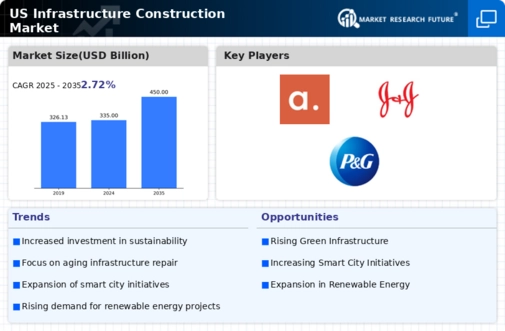The infrastructure construction market in the US is characterized by a competitive landscape that is increasingly shaped by innovation, sustainability, and strategic partnerships. Key players such as Bechtel Corporation (US), Fluor Corporation (US), and Kiewit Corporation (US) are actively pursuing strategies that emphasize technological advancement and operational efficiency. Bechtel Corporation (US), for instance, has been focusing on digital transformation initiatives to enhance project delivery and reduce costs, thereby positioning itself as a leader in the market. Similarly, Fluor Corporation (US) has been investing in sustainable construction practices, which not only align with regulatory trends but also cater to the growing demand for environmentally responsible infrastructure solutions. Kiewit Corporation (US) appears to be leveraging its extensive experience in the sector to expand its regional footprint, particularly in renewable energy projects, which are gaining traction in the current market environment.
The business tactics employed by these companies reflect a broader trend towards localization and supply chain optimization. The market structure is moderately fragmented, with a mix of large multinational corporations and smaller regional firms. This fragmentation allows for a diverse range of services and innovations, although the collective influence of major players like Bechtel and Fluor is significant in shaping industry standards and practices. The competitive dynamics are further complicated by the need for companies to adapt to rapidly changing regulations and client expectations, particularly in the realm of sustainability and digitalization.
In October 2025, Bechtel Corporation (US) announced a partnership with a leading technology firm to develop an AI-driven project management tool aimed at enhancing efficiency and reducing project timelines. This strategic move underscores Bechtel's commitment to integrating advanced technologies into its operations, potentially setting a new benchmark for project execution in the industry. The implications of this partnership could be profound, as it may lead to improved resource allocation and cost savings, thereby enhancing Bechtel's competitive edge.
In September 2025, Fluor Corporation (US) secured a major contract for a renewable energy project in California, valued at approximately $500 million. This contract not only reinforces Fluor's strategic focus on sustainable infrastructure but also highlights the growing importance of renewable energy initiatives in the US market. The successful execution of this project could further solidify Fluor's reputation as a leader in sustainable construction, attracting additional contracts in this burgeoning sector.
In August 2025, Kiewit Corporation (US) expanded its operations into the Midwest by acquiring a regional construction firm specializing in infrastructure development. This acquisition is indicative of Kiewit's strategy to enhance its market presence and diversify its service offerings. By integrating local expertise with its established operational framework, Kiewit is likely to improve its competitive positioning and responsiveness to regional demands.
As of November 2025, the competitive trends in the infrastructure construction market are increasingly defined by digitalization, sustainability, and the integration of AI technologies. Strategic alliances are becoming more prevalent, as companies recognize the need to collaborate in order to innovate and meet evolving client expectations. The shift from price-based competition to a focus on technological advancement and supply chain reliability is evident, suggesting that future competitive differentiation will hinge on the ability to deliver innovative solutions that align with sustainability goals and operational efficiency.
















